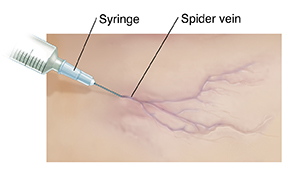The most common way to treat spider and small varicose veins is sclerotherapy. This is a simple office procedure. After treatment, you can return to your daily activities right away. For best results, some veins may need to be treated more than once.
What sclerotherapy does
This treatment causes spider and small varicose veins to disappear over time. It's done by injecting the veins with a chemical that causes them to scar and collapse. The body then reroutes the blood to flow only through the healthy veins. Over time, the treated veins go away. Sclerotherapy will not prevent new spider and varicose veins from forming.
What this treatment involves
Your doctor may use an ultrasound machine to help them find the veins to treat. They will inject the veins using a fine needle. In most cases, this isn’t painful. You may feel a slight burning or stinging. Many veins can be treated in a single session.
After treatment, the injection sites are covered with gauze and tape. You may also have to wear bandages or elastic stockings, as directed.
Recovering at home
At first, your legs will most likely be bruised. For a brief time, they may even look worse than they did before treatment. But you can expect to see good results in 6 to 8 weeks. For the best outcome, here are some helpful hints:
-
Wear elastic stockings or bandages as directed.
-
Raise your legs as advised, to help reduce swelling.
-
Walk each day to increase blood flow.
-
Follow your doctor’s advice about other kinds of exercise.
When to contact your doctor
Contact your doctor right away if you notice:
-
Pain in your legs or feet.
-
Bleeding at injection sites.
-
Extreme swelling or bruising.
-
Fever.
-
Chest pain.
-
Skin breakdown at the site of the injection.


